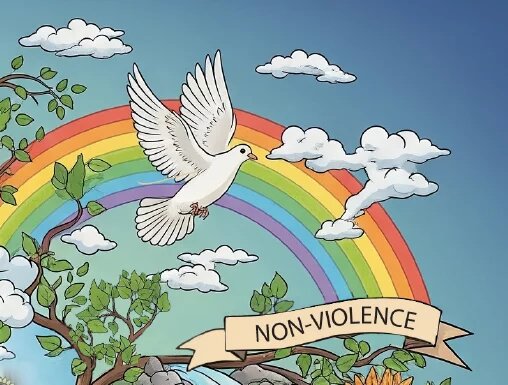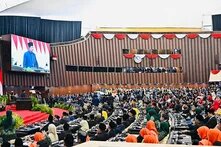Southeast Asia’s record in promoting the notion of non-violence to achieve state and human security is inconsistent. And, while ASEAN’s commitment to the principle of non-interference has been crucial to maintaining peace among its member states, it has assumed practically no role in diffusing intra-state tensions in the region. Through taking a closer look at selected examples of the Mekong Sub-region and beyond, this paper examines the notion of non-violence in Southeast Asia's domestic and international conflicts. In a context of international multilateral frameworks and ASEAN member states commitments, the paper asks if ASEAN should reconsider a more flexible understanding of non-violence by empowering it’s existing institutions, and through adhering to the principles of democracy and inclusion of community interests.

Key Takeaways
- Southeast Asia’s record in promoting the notion of non-violence to achieve state and human security is inconsistent.
- To ensure state security and regional stability, Southeast Asia has employed a range of non-violent means to contain and diffuse conflicts, including ASEAN norms, economic cooperation, and multilateralism. Although imperfect, these elements have arguably contributed to a culture of peace and cooperation in the region. However, ASEAN may need to reconsider its role in light of renewed tensions between Thailand and Cambodia.
- ASEAN’s commitment to the principle of non-interference has largely constrained the organization in taking a role in resolving internal conflicts. As a result, individual states decide whether to use force or democratic measures in response to domestic conflicts, as they see fit. The use of military means contradicts the notion of non-violence.
Executive Summary
Today, the world is faced with mounting challenges marked by heightened geopolitical tensions, all of which are playing out within the context of a weakened global order. As new problems emerge, old ones show no signs of abating. The war in Gaza rages on, while several attempts for a peaceful resolution have failed to bring an end to the ongoing conflict between Russia and Ukraine. Meanwhile, instability in other regions, such as Africa, has resulted in widespread destruction and mass displacement, most notably in the conflict in the Democratic Republic of Congo and Sudan. While Southeast Asia is considered a relatively peaceful region, widespread conflict in Myanmar shows no signs of abating, and a long-standing border dispute between Thailand and Cambodia has reemerged. Amid the turbulence of global politics, the practice of non-violence has become increasingly vital in diffusing contemporary tensions.
The application of the notion of non-violence in Southeast Asia's domestic and international conflicts is explored in detail in the main paper. By “non-violence,” the paper takes the definition as outlined in the Global Greens Charter, adopted in 2001 and recently updated in 2023, which aims to create “a culture of peace and cooperation between states, inside societies and between individuals, as the basis of global security.” Global security goes beyond a narrow definition of state security and the enhancement of military might. Instead, the charter places importance on “pursuing general and complete disarmament, including international agreements to ensure a complete and definitive ban of nuclear, biological and chemical arms, anti- personnel mines and depleted uranium weapons” and “a rigorous code of conduct on arms exports to countries where human rights are being violated.” Regarding the protection of individual security, it considers the “social, economic, ecological, psychological, and cultural aspects of conflict.” This involves “respecting other cultures, eradicating racism, promoting freedom and democracy” while strengthening multilateral frameworks, including the United Nations (UN), as well as regional ones, including the European Union (EU), the African Union (AU), and ASEAN, to name a few. All in all, non-violence seeks to secure both state and human security through the use of peaceful and democratic means, such as respect for equality, the peaceful settlement of conflicts, and cooperation. While the promotion of non-violence is often codified in international agreements and institutions, its sustained practice over time can evolve into a habit or culture of peace and democracy.
In comparison to other regions, Southeast Asia has not witnessed an outbreak of war between two or more states since the end of the Cold War. Although some conflicts persist—occasionally resulting in limited military skirmishes, such as those between Thailand and Myanmar in 2001, and between Thailand and Cambodia in 2011- these incidents were swiftly de-escalated through diplomatic channels and did not escalate into full-scale war. Some would argue that part of this success is attributed to ASEAN’s role in promoting peace and cooperation through inclusive multilateral frameworks incorporating extra-regional partners, joint development, and negotiations. Equally important are ASEAN norms, such as the principle of non-interference, a security and diplomatic practice highly valued by ASEAN member states, which has prevented ASEAN members from criticizing a fellow member state or engaging in military intervention. While these norms and institutions combined have arguably created a level of “culture of peace and cooperation,” this has been accomplished largely through conflict avoidance rather than genuine problem-solving. As a consequence, problems remain, and disputes have been simply swept under the carpet. Renewed tensions between Thailand and Cambodia, which resulted in military clashes in May 2025 and again in late July, illustrate the fragility of this approach.
Although ASEAN has been crucial to maintaining peace among its member states, it has assumed practically no role in diffusing intra-state tensions. The main reason for this is the principle of non-interference, which—while ironically contributing to regional stability and the mitigation of inter-state conflicts—has also granted member states a carte blanche to pursue what they perceive as the most appropriate responses to domestic conflict. As a result, in some cases, the protection of minority rights has been upheld, while bilateral and multilateral cooperation in various stages of peacebuilding, such as mediation and peacekeeping, has contributed to the peaceful resolution of protracted conflicts. The support for peace monitoring in Aceh in 2005, as well as Malaysia’s role in mediating the peace process in Mindanao and Thailand’s southern border provinces, are examples of this. However, without clear procedures to address domestic conflicts in line with democratic values, some ASEAN countries have resorted to military or violent means to suppress unrest, often violating the ASEAN Charter, the Geneva Conventions. With citizens in Myanmar continuing to live in fear and insecurity while ASEAN remains powerless to fulfil what has been agreed upon in the Five Point Consensus (5PC), the organization is confronted with a clear choice: to continue supporting regimes that have little regard for human life, or live up to its own commitment to building a people-centred community. While choosing the former would gradually render ASEAN inconsequential, pursuing the latter would undeniably strengthen its leadership, centrality, resilience, and credibility. Is it time for ASEAN to rethink how it promotes non-violence? A more detailed answer to this question can be found at this link.


